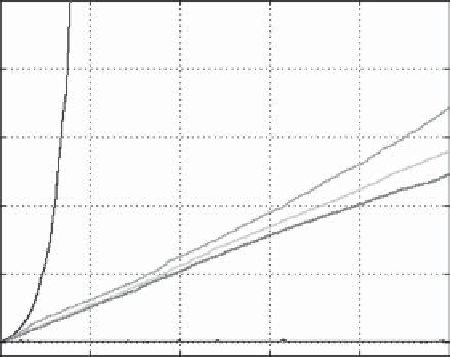Information Technology Reference
In-Depth Information
1.25
OJA
1.2
1.15
OJAn
LUO
1.1
MCA EXIN
1.05
OJA
+
1
0
2000
4000 6000
Iterations
8000
10000
Figure 2.7
Divergences (represented by the evolution of the squared weight modulus) of
the MCA linear neurons with initial conditions equal to the solution. (
See insert for color
representation of the figure
.)
corresponding to
λ
n
=
0
.
1235
<
1. Figure 2.7 [181] shows the different diver-
gences of
w(
t
)
2
2
: OJA yields the worst result (sudden divergence), MCA EXIN
has the slowest divergence, and OJA
+
converges. Figure 2.8 shows the deviation
from the MC direction for LUO. The effect of the orthogonal weight increments
and the start of the sudden divergence are apparent. Figure 2.9 shows the good
approximation of the ODE (2.106) with respect to the LUO stochastic law and
the good estimation of
t
∞
by eq. (2.111).
2.6.2.5 Conclusions
Except for FENG, whose limits are very serious and
will be analyzed later, all other MCA neurons diverge and some of them are
plagued with sudden divergence.
Proposition 69 (MCA Divergence)
LUO and OJA diverge at a finite time
(
sud-
den divergence
)
.OJA
behaves as OJA for noisy input data. OJAn and MCA
EXIN diverge at infinite time, but the former at a faster rate.
+
Proposition 70 (Noisy Input Data)
Noisy input data (i.e., high
λ
n
), worsen
the neuron features. LUO and OJA diverge before the rate of divergence of OJAn
[
which depends exponentially on
λ
n
; see eq.
(
2.107
)]
, which increases more than
that of MCA EXIN
[
which depends on
√
λ
n
; see eq.
(
2.112
)]
. OJAn behaves as
OJA and then diverges at finite time.
In the next section we analyze the problems caused by the divergence.





Search WWH ::

Custom Search